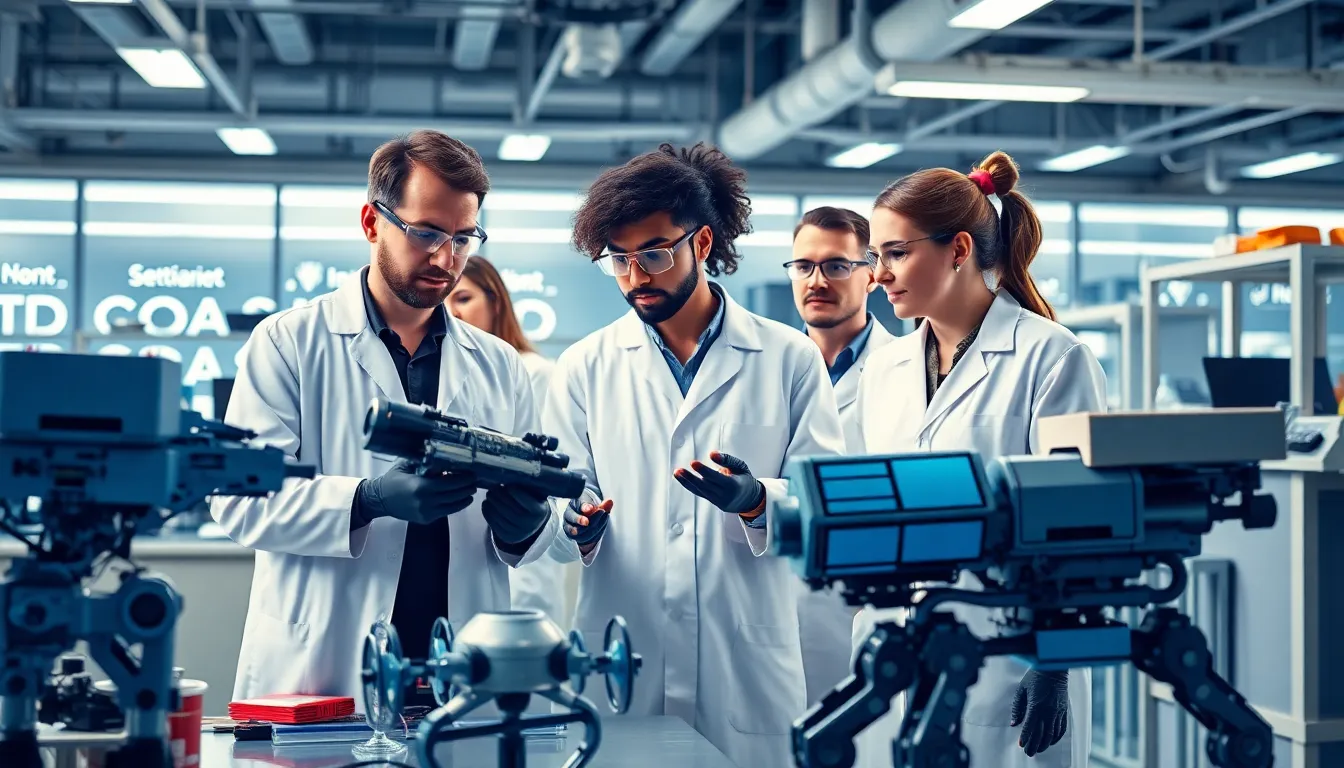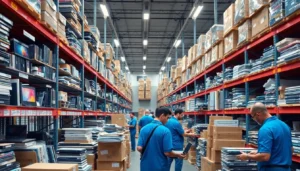In a universe filled with mysteries and cosmic wonders, the Space Technology Mission Directorate (STMD) stands as the rocket fuel behind humanity’s quest for the stars. Picture a team of brilliant minds working tirelessly to develop the next generation of space technologies that could make intergalactic travel as easy as ordering takeout. From advanced propulsion systems to innovative robotics, the STMD is on a mission to turn science fiction into science fact.
Table of Contents
ToggleOverview of Space Technology Mission Directorate
The Space Technology Mission Directorate (STMD) plays a pivotal role in NASA’s mission to push the boundaries of space exploration. Focusing on developing innovative technologies, STMD seeks to enhance capabilities for both crewed and uncrewed missions. Advanced propulsion systems stand out among the areas of research, aiming to improve efficiency and reduce travel time for long-distance space journeys.
Robotic systems are another primary focus for the STMD. They enable precise operations in various environments, from planetary surfaces to deep space. These technologies facilitate scientific investigation, making it easier to gather data and conduct experiments in challenging locales.
Collaboration is essential to STMD’s success. The directorate partners with industry, academic institutions, and other government agencies. This teamwork fosters the exchange of ideas and accelerates technology development. Numerous projects arise from these collaborations, addressing specific challenges within space exploration.
Funding is another critical aspect of STMD’s efforts. The directorate allocates budget resources to support promising technologies, ensuring sufficient investment to transition concepts into actionable solutions. Prioritizing high-impact projects maximizes benefits for future space missions and contributes to scientific knowledge.
Overall, STMD functions as a catalyst in transforming visionary concepts into reality. By integrating cutting-edge technologies into NASA’s missions, the directorate enhances exploration capabilities, making deep space travel increasingly attainable.
Key Objectives

Space Technology Mission Directorate (STMD) focuses on pivotal goals that shape the future of space exploration and Earth sciences. It drives the development of technologies that expand both human capabilities and scientific understanding.
Advancing Space Exploration
STMD plays a crucial role in breaking barriers for space exploration. Advanced propulsion systems are a top priority, optimizing efficiency for long-distance travel. Robotics technology enhances mission capabilities, allowing for operations in various environments. By working closely with industry and academic partners, STMD accelerates the pace of innovation, ensuring that promising concepts transition into viable technologies. Funding is strategically directed toward projects that promise significant returns for upcoming missions. These efforts position STMD as a leader in translating visionary ideas into practical applications for interplanetary exploration.
Enhancing Earth Science
Improving Earth science capabilities is another key objective of STMD. Innovative satellite technologies support better monitoring of climate change and natural disasters. Enhanced data gathering provides researchers with vital information to understand Earth’s systems thoroughly. Collaboration with different agencies fuels advancements in remote sensing technologies, increasing the accuracy of environmental assessments. By prioritizing investments in high-impact projects, STMD contributes to a greater understanding of Earth and its atmosphere. These initiatives bridge the gap between space and terrestrial science, reinforcing the importance of Earth observation in space missions.
Major Programs and Initiatives
Significant initiatives under the Space Technology Mission Directorate (STMD) position it as a leader in advancing space exploration. Each program plays a crucial role in enhancing capabilities for future missions.
Artemis Program
The Artemis Program aims to return humans to the Moon by 2024, focusing on sustainable lunar exploration. Advanced technologies such as modular lunar landers and surface habitats are being developed. The program emphasizes collaboration across agencies and private partnerships. This collaboration channels resources and expertise into creating robust systems for crewed missions. Artemis not only prepares for lunar landing but also sets the groundwork for potential Mars missions. By prioritizing safety and sustainability, it provides NASA with the tools necessary for deep space exploration.
Space Technology Development
Space technology development encompasses various projects, each targeting key technological challenges. Transformative technologies such as in-space manufacturing and advanced robotics are prioritized to improve mission efficiency. Initiatives under this umbrella foster partnerships with industry and academia, ensuring innovative solutions emerge from diverse insights. Technology demonstrations play a central role, validating capabilities in real-world environments. Furthermore, projects focus on autonomous systems to enhance operational reliability during long missions. Every development effort contributes significantly to understanding and utilizing available resources beyond Earth.
Collaborations and Partnerships
Collaboration plays a vital role in the success of the Space Technology Mission Directorate. Partnerships across industries and nations enhance technological advancements and foster innovative solutions.
Industry Collaborations
Industry collaborations rank as a cornerstone of STMD’s strategy. These partnerships leverage private sector expertise and resources to accelerate technology development. Working with companies boosts the design of advanced propulsion systems and autonomous robotic systems. Joint ventures such as those with major aerospace firms lead to breakthroughs in in-space manufacturing capabilities. Moreover, cooperative agreements enable rapid deployment of innovative satellite technologies. They also encourage knowledge-sharing that enhances efficiency and fosters creativity. Numerous funding opportunities focus on high-impact projects, ensuring that investment is directed toward areas with the greatest potential for success.
International Partnerships
International partnerships expand STMD’s reach and influence in global space exploration. Collaborative efforts with space agencies like ESA and JAXA help address shared challenges in technology development. These alliances facilitate the exchange of information and resources, enhancing research in climate monitoring and disaster response. Agreements promote joint missions that benefit from diverse scientific perspectives, optimizing the use of technology for Earth observation. Furthermore, shared projects open pathways for pursuing ambitious objectives such as lunar exploration initiatives. Establishing strong global ties ensures that the mission to explore and study space has a collective impact, reinforcing the importance of international cooperation.
Future Directions
STMD’s commitment to pioneering technologies aligns closely with NASA’s goals for future space exploration. Collaborative initiatives will continue to enhance capabilities for crewed and uncrewed missions. Investments in advanced propulsion systems promise increased efficiency and shorter travel times for deep-space journeys. Robotics development targets enhanced precision in diverse environments, crucial for scientific research and operational success.
Prioritizing partnerships with industry and academia fosters innovation and accelerates technology advancement. Noteworthy projects such as the Artemis Program aim for sustainable lunar exploration, featuring advanced modular landers and surface habitats. In addition, STMD emphasizes the importance of Earth science through innovative satellite technologies that provide critical climate data and disaster monitoring.
Autonomous systems stand at the forefront of future missions, ensuring reliability during prolonged space travel. The directorate’s collaborations with international agencies like ESA and JAXA broaden its impact on global space initiatives, allowing for shared resources in climate research and disaster response.
Investment strategies target high-impact technologies, ensuring that projects contribute significantly to mission success. By supporting promising initiatives, STMD lays the groundwork for both lunar and Martian explorations. Continued focus on innovative solutions will help transform ambitious concepts into reality, enabling deeper understanding of Earth’s systems and space environments.
Future directions for STMD indicate a progressive path, united by collaboration, technological advancement, and sustainable practices in exploration. Each step forward builds on a foundation of shared knowledge and resources, empowering humanity’s quest to explore the cosmos.
The Space Technology Mission Directorate stands as a pivotal entity in the realm of space exploration and Earth sciences. Its commitment to innovation and collaboration drives the development of groundbreaking technologies that enhance both crewed and uncrewed missions. By investing in advanced propulsion systems and robotics, STMD not only accelerates space travel but also enriches scientific understanding of Earth’s systems.
Through strategic partnerships with industry and academia, STMD fosters a culture of creativity that propels the future of space technology. As it continues to bridge the gap between ambitious concepts and tangible advancements, STMD plays a crucial role in shaping the future of exploration and ensuring a sustainable approach to both lunar and Martian endeavors.



